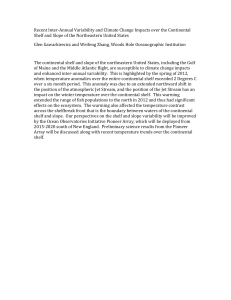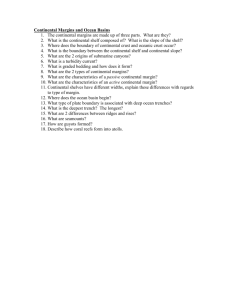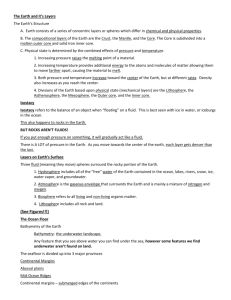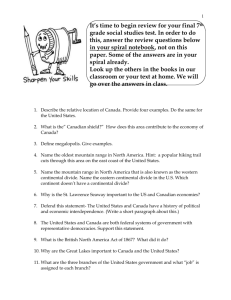Word
advertisement
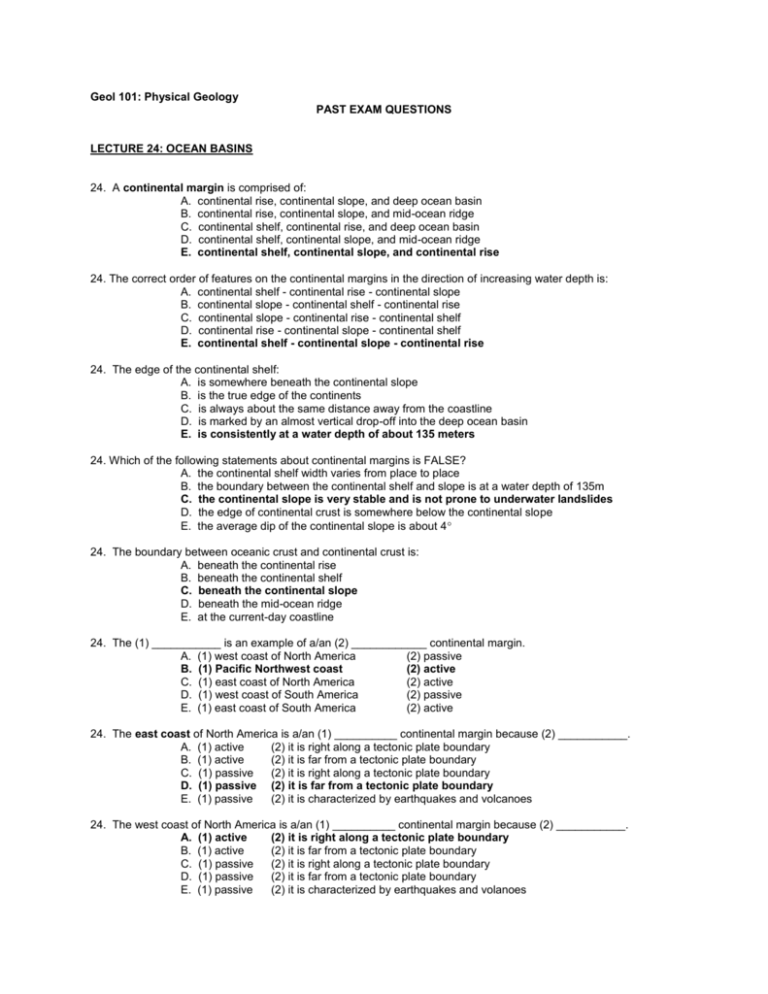
Geol 101: Physical Geology PAST EXAM QUESTIONS LECTURE 24: OCEAN BASINS 24. A continental margin is comprised of: A. continental rise, continental slope, and deep ocean basin B. continental rise, continental slope, and mid-ocean ridge C. continental shelf, continental rise, and deep ocean basin D. continental shelf, continental slope, and mid-ocean ridge E. continental shelf, continental slope, and continental rise 24. The correct order of features on the continental margins in the direction of increasing water depth is: A. continental shelf - continental rise - continental slope B. continental slope - continental shelf - continental rise C. continental slope - continental rise - continental shelf D. continental rise - continental slope - continental shelf E. continental shelf - continental slope - continental rise 24. The edge of the continental shelf: A. is somewhere beneath the continental slope B. is the true edge of the continents C. is always about the same distance away from the coastline D. is marked by an almost vertical drop-off into the deep ocean basin E. is consistently at a water depth of about 135 meters 24. Which of the following statements about continental margins is FALSE? A. the continental shelf width varies from place to place B. the boundary between the continental shelf and slope is at a water depth of 135m C. the continental slope is very stable and is not prone to underwater landslides D. the edge of continental crust is somewhere below the continental slope E. the average dip of the continental slope is about 4 24. The boundary between oceanic crust and continental crust is: A. beneath the continental rise B. beneath the continental shelf C. beneath the continental slope D. beneath the mid-ocean ridge E. at the current-day coastline 24. The (1) ___________ is an example of a/an (2) ____________ continental margin. A. (1) west coast of North America (2) passive B. (1) Pacific Northwest coast (2) active C. (1) east coast of North America (2) active D. (1) west coast of South America (2) passive E. (1) east coast of South America (2) active 24. The east coast of North America is a/an (1) __________ continental margin because (2) ___________. A. (1) active (2) it is right along a tectonic plate boundary B. (1) active (2) it is far from a tectonic plate boundary C. (1) passive (2) it is right along a tectonic plate boundary D. (1) passive (2) it is far from a tectonic plate boundary E. (1) passive (2) it is characterized by earthquakes and volcanoes 24. The west coast of North America is a/an (1) __________ continental margin because (2) ___________. A. (1) active (2) it is right along a tectonic plate boundary B. (1) active (2) it is far from a tectonic plate boundary C. (1) passive (2) it is right along a tectonic plate boundary D. (1) passive (2) it is far from a tectonic plate boundary E. (1) passive (2) it is characterized by earthquakes and volanoes 24. Which of the following is NOT an example of an active continental margin? A. Pacific Northwest B. East coast of North America C. coastal California D. the circum-Pacific belt E. the coast of Chile, western South America 24. Which of the following portion of the ocean floor is the flattest? A. ocean trenches B. ocean ridges C. continental slope D. abyssal plains E. continental rise 24. The deepest part of all ocean basins is: A. the continental shelf B. the abyssal plains C. the ocean trenches D. the ocean ridges E. somewhere beneath the continental slope 24. Which of the following is NOT found in the deep ocean basins? A. abyssal plains B. ocean trenches C. ocean ridges D. continental shelf E. all of the above are in the deep ocean basins 24. Which of the following is a portion of the world’s longest mountain range? A. Marianas trench B. Himalayas C. Caledonides D. Cascades E. mid-Atlantic ridge 24. Which of the following portions of typical oceanic lithosphere would most likely occur on the sea floor itself? A. pillow basalt B. sheeted dike complex C. peridotite D. gabbro E. serpentinite 24. The correct order of the 4 layers of rock types that make up oceanic crust, from top to bottom is: A. pillow basalts – sediments – gabbro – sheeted dike complex B. pillow basalts – sheeted dike complex – gabbro – sediments C. sediments – pillow basalts – sheeted dike complex – gabbro D. sediments – pillow basalts – gabbro – sheeted dike complex E. sheeted dike complex – gabbro – pillow basalts – sediments 24. The tectonic plate that used to exist off the west coast of North America but which has long since been subducted, was the: A. Juan da Fuca plate B. Farallon plate C. California plate D. Pacific plate E. Exotic plate

